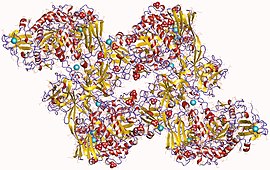| Pullulanase | |||||||||
|---|---|---|---|---|---|---|---|---|---|
 Debranching enzyme homotetramer, Klebsiella oxytoca | |||||||||
| Identifiers | |||||||||
| EC no. | 3.2.1.41 | ||||||||
| CAS no. | 9075-68-7 | ||||||||
| Databases | |||||||||
| IntEnz | IntEnz view | ||||||||
| BRENDA | BRENDA entry | ||||||||
| ExPASy | NiceZyme view | ||||||||
| KEGG | KEGG entry | ||||||||
| MetaCyc | metabolic pathway | ||||||||
| PRIAM | profile | ||||||||
| PDB structures | RCSB PDB PDBe PDBsum | ||||||||
| |||||||||
Pullulanase (EC 3.2.1.41, limit dextrinase, amylopectin 6-glucanohydrolase, bacterial debranching enzyme, debranching enzyme, α-dextrin endo-1,6-α-glucosidase, R-enzyme, pullulan α-1,6-glucanohydrolase) is a specific kind of glucanase, an amylolytic exoenzyme, that degrades pullulan.[1][2][3] It is produced as an extracellular, cell surface-anchored lipoprotein by Gram-negative bacteria of the genus Klebsiella. Type I pullulanases specifically attack α-1,6 linkages, while type II pullulanases are also able to hydrolyse α-1,4 linkages. It is also produced by some other bacteria and archaea. Pullulanase is used as a processing aid in grain processing biotechnology (production of ethanol and sweeteners).
Pullulanase is also known as pullulan-6-glucanohydrolase (Debranching enzyme). Its substrate, pullulan, is regarded as a chain of maltotriose units linked by α-1,6-glycosidic bonds. Pullulanase will hydrolytically cleave pullulan (α-glucan polysaccharides).